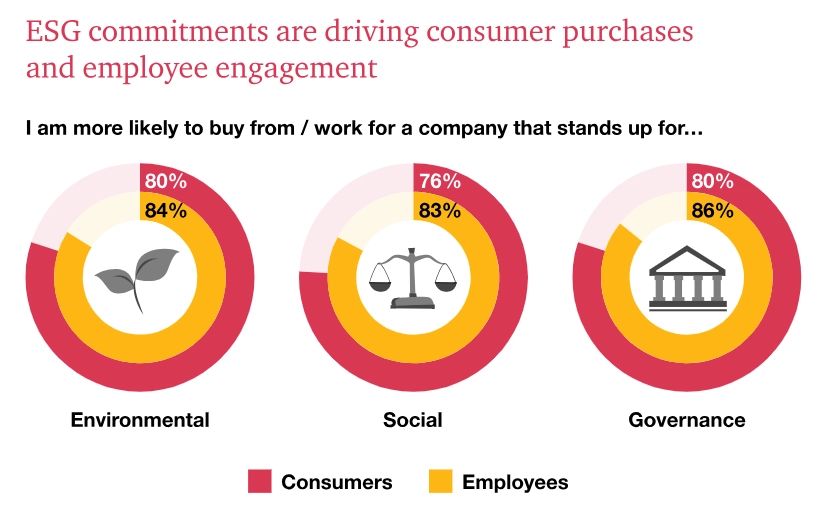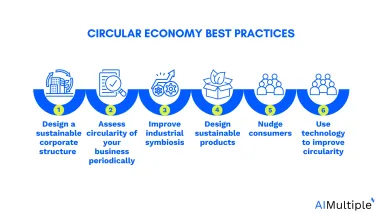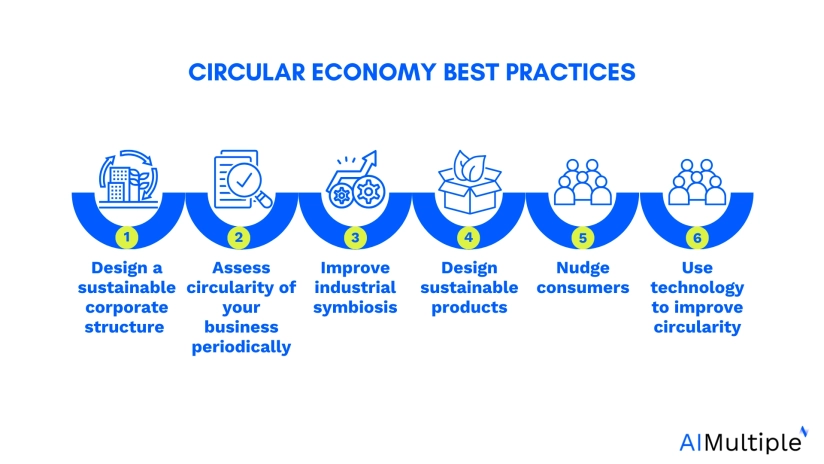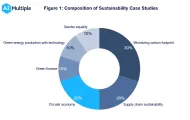Our economy was just 6.9% circular in 2024, which implies we use 93.1% of nonrecycled materials in production.1 Employing nonrecycled resources for 92.8% of our economic activities also suggests a significant “circularity gap” that is linked to inefficient business practices. Circular economy (CE) by closing the circularity gap practices would contribute 4.5 trillion dollars by 2030.2
Learn the top 6 best circular economy best practices to minimize the circularity gap not only for environmental stewardship but also to increase company profitability:
| Best Practice | Tools/Enablers | How It Closes the Circularity Gap |
|---|---|---|
| Sustainable corporate structure | Strategy frameworks, KPI dashboards | Aligns strategy with circular goals, enabling focused action. |
| Assess circularity regularly | ESG platforms | Tracks progress and identifies improvement areas. |
| Improve industrial symbiosis | Shared ERPs, waste tracking tools | Turns waste into input for others, reducing resource use. |
| Design sustainable products | Eco-design software, material flow tools | Boosts durability, recyclability, and reuse potential. |
| Nudge consumers | Loyalty programs, QR tracking | Encourages return, reuse, and responsible use. |
| Use technology for circularity | IoTs, digital twins | Optimizes resources and enables smarter operations. |
1. Design a sustainable corporate structure
It would be naïve to expect to identify a viable strategy toward a goal without changing the company’s organizational scheme. As a result, the first step for a corporation to reduce the circularity gap is to develop a team that is responsible for:
- Determining current pain points of the organization.
- Estimating current and expected tangible-intangible costs of current pain points (e.g: plastic tax, carbon tax, excessive raw material expenditure, bad reputation etc.)
- Estimating current and expected tangible-intangible returns of improving circularity of the company (e.g: tax reduction, good reputation, less expenditures due to efficiency, government subsidies etc.)
- Setting achievable goals for short and long-term periods subject to tangible-intangible cost and return analysis, infrastructure, human capital, financial capital of the company.
- Building strategy to achieve short and long-term goals.
- Shifting from extracting resources to helping nature regenerate.
- Prioritizing the actions where potential return/effort ratio is high.
- Monitoring the execution and output of actions by setting KPIs (Firm use x% renewed materials until the end of the year).
It’s critical to hire employees with diverse skill sets and backgrounds for a circularity team. CE solutions necessitate a holistic approach that includes product design, engineering, supply chain management, environmental accounting, traditional accounting, marketing, and understanding consumer-investor psychology. As a result, leaders must ensure that a department is established to address CE’s transdisciplinary demands.
Real-life example
In São Paulo, the Connect the Dots project supports local farmers by paying extra for food grown with regenerative methods, helping protect nature and promote social inclusion.3
Natura, a cosmetics company in South America, works with thousands of families to harvest plant ingredients from the Amazon without cutting down trees, helping preserve millions of hectares of rainforest.
GreenWave’s 3D ocean farming grows seaweed and shellfish on simple rope systems, creating food and materials while restoring marine ecosystems.
2. Assess circularity of your business periodically
Defining present pain points and tracking changes is meaningful only if business circularity is measured on a regular basis. There are metrics that help firms evaluate their processes, such as resource productivity, percentage of circular water use, percentage of recycled material used, and so on.
Furthermore, around 70% of businesses intend to attract investors and customers by voluntarily publishing such indicators to demonstrate their responsiveness.4 You can find most large companies’ statements about their environmental responsiveness and improvement of specific CE metrics over time with a Google search.
It’s a reasonable kind of self-promotion as more than half of shoppers do online research before purchasing a product to learn about the firms’ environmental, social, and governance (ESG) standards.5 In addition, more than 70% of customers are concerned about a firms’ environmental or social impact.
To learn more about circularity metrics you can read our article Top Metrics to Assess the Circularity of Businesses. Additionally, you can read our article on carbon footprint calculation tools.
Figure 1. Percentage of consumers are worried about environmental or social impact of firms

Source: PwC6
3. Improve industrial symbiosis
The essence of CE is turning someone’s waste into value for your operations. Thus, cooperation of organizations is a must to achieve full CE.
There are many examples of industrial symbiosis:
- Waste heat from one manufacturer-energy producer can transfer the greenhouses for reducing energy bills and GHG emissions.7
- Wastewater from some manufacturers that do not release toxic chemicals can be reused by other manufacturers or farmers after simple water retreatment.
- Waste car tires can be turned into materials for civil engineering
- Organic waste can be turned into biogas which is a substitute for natural gas.
- Organic waste can be turned into organic fertilizer.8
To find out new ways of industrial symbiosis, companies need employees with holistic approaches ideally who experience different industries in their careers. Thus, they can be aware of the quality and quantity of other industries’ wastes. Such knowledge can trigger the innovation for using others’ waste as a resource.
4. Design sustainable products
According to the European Commission, product design accounts for up to 80% of a product’s environmental impact.9 Consider a traditional automobile manufacturer: the type, quantity, and quality of material used, aerodynamic features, and engine size are all factors that influence the car’s average life-time, oil consumption per 100 kilometers, recyclability, etc. As a result, the average environmental footprint of a product is determined by its design.
Manufacturers can improve their design in a circular way by considering the following factors:
1. Adopt product-service system (PSS)
Rather than selling the product to your customers, lease or rent it to ensure re-usage of a single item by different entities. Such a business strategy implies that manufacturers design the goods they produce in a durable and repairable way since they obtain the product. PSS also supports product stewardship and quality of after-sales capabilities due to similar reasoning. Rolls Royce’s long lasting power by the hour initiative is an example of PSS.10
2. Increase recyclability of your product
The better recyclability of a product is related with a more lego-like design that is easily disassembled. This means that another entity, or even your company, can utilize your products as raw materials at the end of their life cycle.
3. Use biodegradable raw materials
Due to numerous leakages, actual recycling rates tend to be lower than recyclability rates. For example, a consumer can throw a beverage package into the ocean. Manufacturers might choose biodegradable raw materials in nature to reduce the environmental impact of such circumstances.
Real-life example
Apeel uses a plant-based coating made from fruit and vegetable parts to protect fresh produce. This cuts down food waste and replaces plastic wrap, showing how natural materials can help in a circular economy.11
4. Dematerialization of product
When you can produce the same product quality with less raw resources, you save money on raw materials, transportation, and the environmental impact of acquiring raw materials and delivering heavier goods.
5. Produce durable-repairable goods
The longer the life time of the product means the higher the corporate circularity. Adopting PSS as a business strategy incentivizes your company to manufacture long lasting repairable products but you can build reliable goods anyway to improve your circularity metrics which helps to attract consumers and investors.
5. Nudge consumers
To close the circularity gap, consumers must assist businesses. The greatest approach to accomplish this is to reward them for being proactive. Beer producers’ deposit schemes are a good example of motivating consumers to be responsible. When customers return their empty bottles to the market, they are given a monetary reward. Beer companies collect empty bottles when they supply the new ones for the supermarket. Thus, the same vehicle brings the raw materials into the company after delivery.
Nowadays, a variety of industries collect consumed items to use them as a raw material for new supplies:
- Timberland: Offers discounts to the consumers who bring their old shoes.12
- Renault: Offers up to 3000 £ discount in the UK for customers who bring their old cars.13
- Many electric, electronic, and smartphone companies offer discounts to customers who bring their old furniture/smartphones.
The deposit system is not the only way to nudge consumers toward CE practices. For instance, Starbucks offers a discount for customers who bring their own cups.14 Similarly, many supermarkets charge a certain amount for using nylon bags. Perhaps, in the near future businesses from other industries adopt such a strategy. For instance a toothpaste company can offer a discount for customers who refill their tubes by using dispensers.
6. Use technology to improve circularity
Technology can be an enabler for improving circularity measurement, industrial symbiosis and increasing efficiency.
Cloud supply chain ERP systems
Cloud supply chain ERP systems make data gathering and interpretation easier for analyzing corporate circularity. They keep track of all supply chain operations such as energy use, water consumption, raw material quantities, and so on. Specific ERP systems that are built for sustainability related monitoring automatically calculate metrics like carbon footprint when the user runs a related query.
Such tools can also connect your down and up supply chain if other organizations agree to collaborate. As a result, cloud ERP solutions increase the likelihood of industrial symbiosis because parties can monitor one other’s operations.
Telematics
Telematics or smart devices are the data sources for companies. They provide information about the environment they are deployed in. Thus, they can help companies to realize inefficiencies and guide them to take actions to minimize it.
3D printers
3D printers reduce the need for intermediate goods to be transported from one location to another. To reduce environmental impact and transportation costs, computerized files of intermediate goods can be delivered digitally and printed there. When the per-product mass of intermediate items is high and the distance between the two locations is long, additive manufacturing is especially beneficial.
You can also read our Top Digital Technologies that Improve Corporate Sustainability article to learn more about digital transformation and sustainability.
External Links
- 1. The Circularity Gap Report 2025. Circle Economy Foundation. Accessed: September/19/2024.
- 2. The Circular Economy Could Unlock $4.5 trillion of Economic Growth, Finds New Book by Accenture.
- 3. Circular economy principles: Regenerate nature.
- 4. Circular Metrics Landscape Analysis. WBCSD.
- 5. Holiday Outlook 2024: PwC .
- 6. 2021 ESG Consumer Intelligence Series: PwC .
- 7. Vourdoubas, J. (2018). Possibilities of using industrial waste heat for heating greenhouses in northern greece. Journal of Agricultural Science, 10(4), 116-123.
- 8. How a 19 Year-Old from Kosovo is Turning Waste into Organic Fertilizer | UNICEF Kosovo Programme.
- 9. Access denied | The Joint Research Centre: EU Science Hub.
- 10. TotalCare® | Rolls-Royce .
- 11. Working with nature to make food last longer: Apeel.
- 12. Timberland Announces Global Product Take-Back Program in Partnership With ReCircled. Business Wire
- 13. New for Old scheme. Renault Premium.
- 14. Starbucks brings back personal reusable cups to Starbucks cafes in the U.S. Starbucks.





Comments
Your email address will not be published. All fields are required.